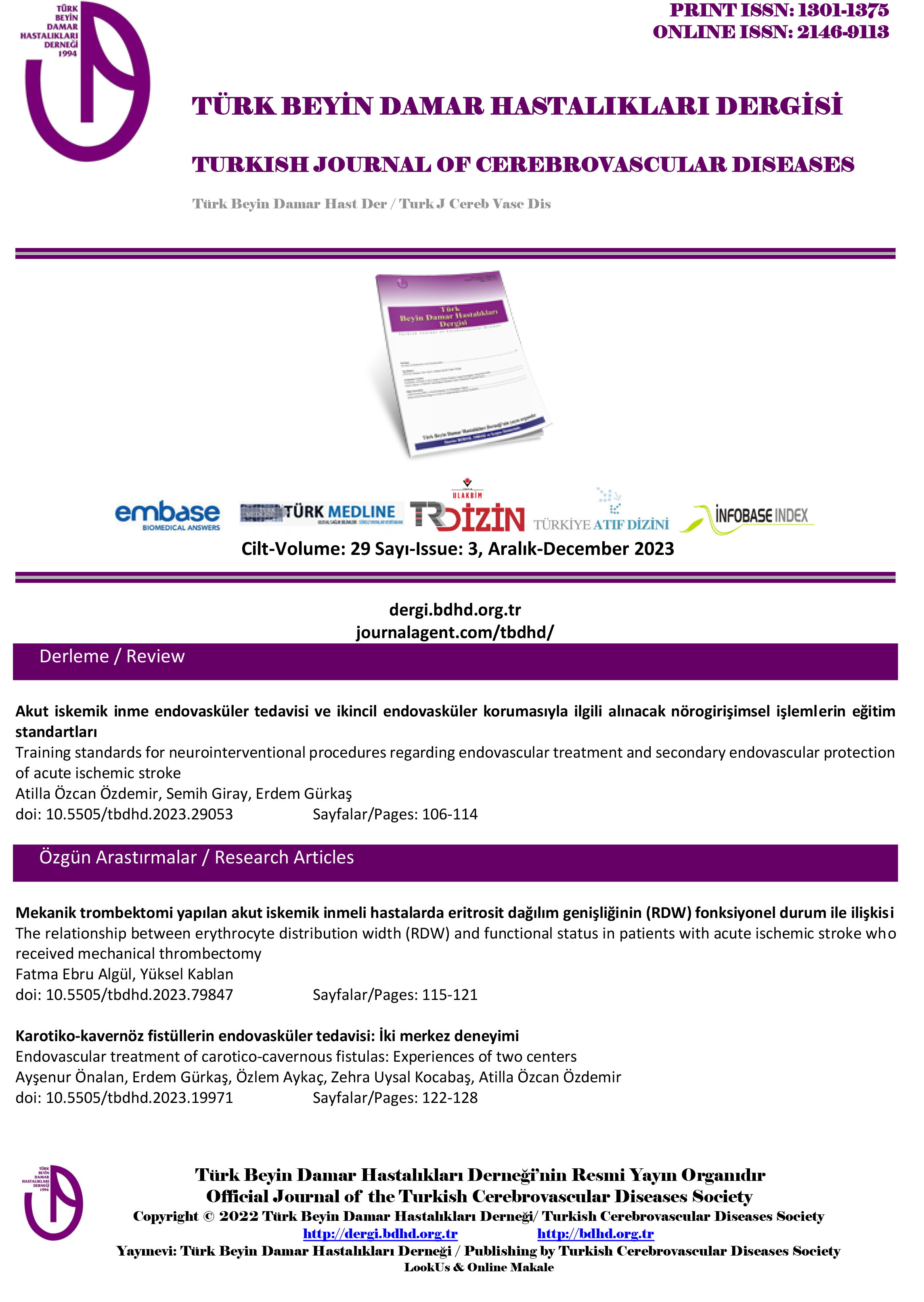Nöroyoğun bakım ünitesindeki akut inmeli hastalarda sonuçları tahmin etmede Full Outline of UnResponsiveness (FOUR) skorunun Glasgow Koma Skalası (GKS) ile karşılaştırılması
Arsida Bajrami1, Murat Çabalar2, Songül Şenadim1, Vildan Yayla31İstabul Aydın Üniversitesi Tıp Fakultesi, Nöroloji Kliniği, İstanbul, Türkiye2Sağlık Bilimleri Üniversitesi, Başakşehir Çam ve Sakura Şehir Hastanesi, Nöroloji Kliniği, İstanbul, Türkiye
3Sağlık Bilimleri Üniversitesi, Bakırköy Dr Sadi Konuk Eğitim ve Araştırma Hastanesi, Nöroloji Kliniği, İstanbul, Türkiye
GİRİŞ ve AMAÇ: Nöroyoğun bakım ünitelerinde (NYBÜ) takip edilen ve bilinç bozukluğu eşlik eden inme hastalarında, bilinç kaybının şiddeti değerlendirilerek prognoz hakkında fikir edinebilir. Bu çalışmada NYBÜsinde takip edilen inme hastalarının özelliklerinin ve prognoz hakkında GKS (Glaskow Koma skalası), FOUR skoru ve NIHSSin (National Institutes of Health Stroke Scale) kestirim gücünün belirlenmesi amaçlanmıştır.
YÖNTEM ve GEREÇLER: Akut inme tanısı ile başvuran ve NYBÜde yatırılan 59 hasta çalışmaya dahil edilmiştir. İki farklı nöroloji uzmanlık öğrencisi tarafından, birbirinden bağımsız olarak ilk başvuru sırasında ve 72. saatinde GKS ve FOUR skoru, geliş ve çıkış NIHSS skorları hesaplanmıştır. Demografik bilgileri, risk faktörlerinin varlığı ve nörogörüntüleme sonuçları kaydedildi. İnme subtiplere ayrılarak sınıflandırma yapıldı. Ayrıca tüm hastaların yatış süreleri, NYBÜden taburculuk, yatış sırasında ve ilk 30 gün içinde entübasyon ve mortalite kaydedildi ve bu parametreleri kullanarak GKS ve FOUR skoru prognoz kestirim güçleri karşılaştırıldı.
BULGULAR: Hastaların yaş ortalaması 68,6 ± 13,4 yıl olup 4 hastada hemorajik inme, 55 hastada iskemik inme saptandı. Ortalama geliş NIHSS 13,1 ve çıkış NIHSS 10 idi. Araştırmacılar arasında, geliş ve 72.saatteki GKS ve FOUR skoru açısından istatistiksel olarak anlamlı pozitif yönlü yüksek derecede korelasyon (r=989) saptandı. Geliş ve yatışın 72. saatindeki GKS ve FOUR skoru, hastanede yatış sırasındaki ve 30 günlük mortalite kestirim güçleri benzer bulundu.
TARTIŞMA ve SONUÇ: FOUR skorunun prognostik değeri ve farklı araştırmacılar arasındaki tutarlılığı anlamlı derecede yüksek bulundu. İnme hastalarının başvuruları ve NYBÜ'lerinde takipleri sırasında GKS ve FOUR skorunun birlikte progozu değerlendirmede etkin olduğu kanaatindeyiz.
A comparison of Full Outline of UnResponsiveness (FOUR) score with Glasgow Coma Scale (GCS) in predicting outcomes among patients with acute stroke patients in neurointensive care unit
Arsida Bajrami1, Murat Çabalar2, Songül Şenadim1, Vildan Yayla31Istanbul Aydin University Faculty of Medicine, Department of Neurology, Istanbul, Türkiye2University of Health Sciences, Basaksehir Cam and Sakura City Hospital, Department of Neurology, Istanbul, Türkiye.
3University of Health Sciences, Bakirkoy Sadi Konuk Training and Research Hospital, Department of Neurology, Istanbul, Türkiye.
INTRODUCTION: Stroke patients treated with disorders of consciousness in the neurointensive care unit (NICU) can be assessed by evaluating the severity of unconsciousness and get an idea of the prognosis. The aim of this study was to determine the characteristics of stroke patients followed up in the NICU and the predictive power of GCS (Glasgow Coma Scale), FOUR score and NIHSS (National Institutes of Health Stroke Scale) on prognosis.
METHODS: A total of 59 patients admitted with a diagnosis of acute stroke and hospitalised in the NICU were included in the study. GCS and FOUR scores, and NIHSS scores on admission and at 72nd hours were calculated independently by two different neurology speciality students. Demographic information, presence of risk factors and neuroimaging results were recorded. Classification was made by dividing stroke into subtypes. Furthermore, the length of hospitalisation, discharge from the NICU, intubation during hospitalisation and within the first 30 days, and mortality were recorded for all patients, and the prognosis predictive power of GCS and FOUR score were compared using these parameters.
RESULTS: The mean age of the patients was 68.6 ± 13.4 years. 4 patients had haemorrhagic stroke and 55 patients had ischaemic stroke. The mean admission NIHSS was 13.1 and discharge NIHSS was 10. A statistically significant positive correlation (r=989) was found between the investigators in terms of GCS and FOUR score at arrival and 72nd hours. The GCS and FOUR score at 72nd hours of admission and hospitalisation, and the predictive power of mortality during hospitalisation and 30-day mortality were similar.
DISCUSSION AND CONCLUSION: The prognostic value of the FOUR score and its consistency between different investigators were found to be significantly high. We believe that GCS and FOUR score together are effective in the prognostic evaluation of stroke patients during admission and follow-up in the NICUs.
Sorumlu Yazar: Songül Şenadim, Türkiye
Makale Dili: İngilizce










